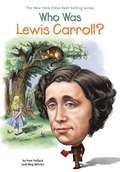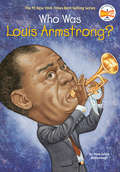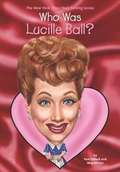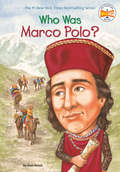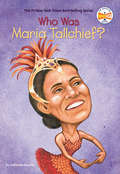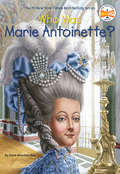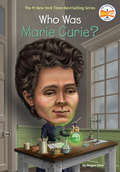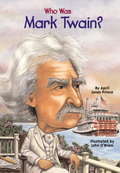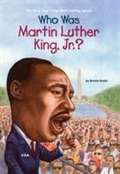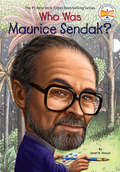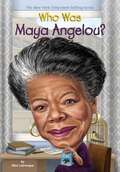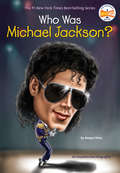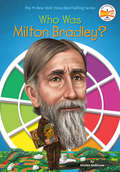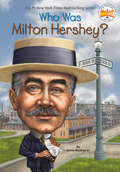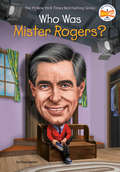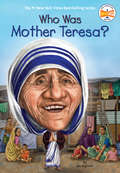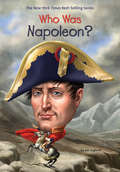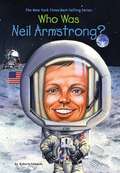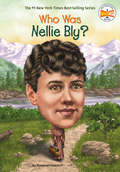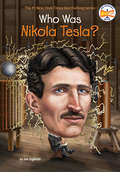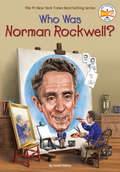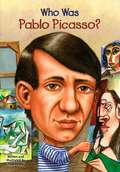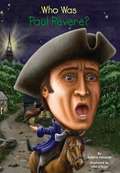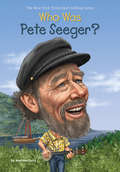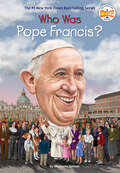Special Collections
Who Was? A Series of Biographies for Kids
- Table View
- List View
Who Was Lewis Carroll?
by Pam Pollack and Meg Belviso and Joseph J. Qiu and Who HqMeet the man who created Alice, the Mad Hatter, and Tweedle Dee and Tweedle Dum!Lewis Carroll is the pen name of Charles L. Dodgson, a mathematician and church deacon, who taught at Oxford University. He was inspired to write his best known works, Alice's Adventures in Wonderland and Through the Looking Glass, by one of the Dean's daughters, Alice Liddell. The books were hugely successful and brought Carroll wide acclaim, especially for the nonsense poems "Jabberwocky" and The Hunting of the Snark.Children and adults continue to be delighted by the fantasy of the Alice stories, which have been the basis of plays and movies since their publication in Victorian England during the 1860s and 1870s.
Who Was Louis Armstrong?
by Yona Zeldis Mcdonough and John O'Brien and Nancy HarrisonIf not for a stint in reform school, young Louis Armstrong might never have become a musician. It was a teacher at the Colored Waifs? Home who gave him a cornet, promoted him to band leader, and saw talent in the tough kid from the even tougher New Orleans neighborhood called Storyville. But it was Louis Armstrong?s own passion and genius that pushed jazz into new and exciting realms with his amazing, improvisational trumpet playing. His seventy-year life spanned a critical time in American music as well as black history.
Who Was Lucille Ball?
by Pam Pollack and Meg Belviso and Nancy Harrison and Gregory CopelandWho doesn't love Lucy? The legendary actress, producer, and comedian steps into the Who Was? spotlight.Much like her hit TV show, I Love Lucy, Americans in the 1950s fell in love with Lucy. Born in New York in 1911, Lucille Ball was always a natural performer. She danced in the chorus of Broadway shows and acted in small parts in Hollywood movies. But Ball's true gift was comedy. She found a way to showcase her gifts in 1951 when CBS gave her the chance to star in a sitcom. She based the show on her life and called it I Love Lucy. Over sixty years later, it is still one of the most loved television shows of all time. Lucille Ball became the first woman to run a major television studio, Desilu, and her comedic genius has kept people laughing for generations.
Who Was Marco Polo?
by Joan Holub and John O'Brien and Nancy HarrisonMarco Polo was seventeen when he set out for China . . . and forty-one when he came back! More than seven hundred years ago, Marco Polo traveled from the medieval city of Venice to the fabled kingdom of the great Kublai Khan, seeing new sights and riches that no Westerner had ever before witnessed. But did Marco Polo experience the things he wrote about . . . or was it all made-up? Young readers are presented with the facts in this entertaining, highly readable Who Was . . . ? biography with black-and-white artwork by John O?Brien.
Who Was Maria Tallchief?
by Catherine Gourley and Nancy Harrison and Val Paul TaylorBorn in 1925, Maria Tallchief spent part of her childhood on an Osage reservation in Oklahoma. With the support of her family and world-renowned choreographer George Balanchine, she rose to the top of her art form to become America's first prima ballerina. Black-and-white illustrations provide visual sidebars to the history of ballet while taking readers through the life of this amazing dancer.
Who Was Marie Antoinette?
by John O'Brien and Dana Meachen RauFrom the palaces of Austria to the mirrored halls of Versailles, Marie Antoinette led a charmed life. She was born into royalty in 1755 and married the future king of France at age 15. By 21 she ascended to the throne and enjoyed a lavish lifestyle of masquerade balls, sky-high wigs, and extravagant food. But her taste for excess ruffled many feathers. The poor people of France blamed Marie Antoinette for their poverty. Her spending helped incite the French Revolution. And after much public outcry, in 1793 she quite literally lost her head because of it. Whether she was blameless or guilty is debatable, but Marie Antoinette remains woven into the fabric of history and popular culture.
Who Was Marie Curie?
by Megan Stine and Nancy Harrison and Ted HammondBorn in Warsaw, Poland, on November 7, 1867, Marie Curie was forbidden to attend the male-only University of Warsaw, so she enrolled at the Sorbonne in Paris to study physics and mathematics. There she met a professor named Pierre Curie, and the two soon married, forming one of the most famous scientific partnerships in history. Together they discovered two elements and won a Nobel Prize in 1903. (Later Marie won another Nobel award for chemistry in 1911.) She died in Savoy, France, on July 4, 1934, a victim of many years of exposure to toxic radiation.
Who Was Mark Twain?
by April Jones Prince and John O'Brien and Nancy HarrisonA humorist, narrator, and social observer, Mark Twain is unsurpassed in American literature. Best known as the author of The Adventures of Huckleberry Finn, Mark Twain, not unlike his protagonist, Huck, has a restless spirit. He found adventure prospecting for silver in Nevada, navigating steamboats down the Mississippi, and making people laugh around the world. But Twain also had a serious streak and decried racism and injustice. His fascinating life is captured candidly in this enjoyable biography.
Who Was Martin Luther King, Jr.?
by Bonnie BaderDr. Martin Luther King, Jr. was only 25 when he helped organize the Montgomery Bus Boycott and was soon organizing black people across the country in support of the right to vote, desegregation, and other basic civil rights. Maintaining nonviolent and peaceful tactics even when his life was threatened, King was also an advocate for the poor and spoke out against racial and economic injustice until his death from an assassin's bullet in 1968. With clearly written text that explains this tumultuous time in history and 80 black-and-white illustrations, this Who Was book celebrates the vision and the legacy of a remarkable man.
Who Was Maurice Sendak?
by Nancy Harrison and Stephen Marchesi and Janet PascalIt seems entirely fitting that Maurice Sendak was born on the same day that Mickey Mouse first made his cartoon debut--June 10, 1928. Sendak was crazy about cartoons and comic books, and at twelve, after seeing Disney's Fantasia, he decided that he was going to become an illustrator. His love of childrens books began early: often sick and confined to bed, little Maurice read and read and read. Though many of his own stories were light and funny, the most important ones--Where the Wild Things Are, In the Night Kitchen, Outside Over There--dealt with anger, jealousy, abandonment, content that had never before been the subject of picture books. As well as covering career highlights, this easy to read, illustrated biography also describes the personal life of this genius. Who Was Maurice Sendak is perfect for kids wild about one of the most influential children's book artists of the twentieth century!
Who Was Maya Angelou?
by Nancy Harrison and Dede Putra and Ellen LabrecqueBorn in Missouri in 1928, Maya Angelou had a difficult childhood. Jim Crow laws segregated blacks and whites in the South. Her family life was unstable at times. But much like her poem, "Still I Rise," Angelou was able to lift herself out of her situation and flourish. She moved to California and became the first black--and first female--streetcar operator before following her interest in dance. She became a professional performer in her twenties and toured the U.S. and Europe as an opera star and calypso dancer. But Angelou's writing became her defining talent. Her poems and books, including I Know Why the Caged Bird Sings, brought her international acclaim.
Who Was Michael Jackson?
by Megan StineBorn in Gary, Indiana, on August 29, 1958, Michael Jackson was definitely not a regular kid. A superstar with The Jackson 5 before he was eight years old, he became the King of Pop as a solo artist. Michael was a creative--yet deeply troubled--genius who always remained devoted to his art right up until his death is 2009 before a much anticipated tour. He had a pitch-perfect voice and footwork that his idol Fred Astaire admired. Who will ever forget the Moonwalk? Kids today who only know Jackson through video performances are nevertheless fascinated by him. Megan Stine provides a sensitive, fair-minded depiction of this unique music legend.
Who Was Milton Bradley?
by Nancy Harrison and Kirsten Anderson and Tim FoleyMeet the man behind the board games: Milton Bradley.Born in Maine in 1836, Milton Bradley moved with his family to the working-class city of Lowell, Massachusetts, at age 11. His early life consisted of several highs and lows, from graduating high school and attending Harvard to getting laid off and losing his first wife. These experiences gave Bradley the idea for his first board game: The Checkered Game of Life. He produced and sold Life across the country and it quickly became a national sensation. Working with his company, the Milton Bradley Company, he continued to produce board games, crayons, and kid-friendly school supplies for the rest of his life. He is often credited as the father of board games, and the Milton Bradley Company has created Battleship, Jenga, Yahtzee, Trouble, and many more classic games.
Who Was Milton Hershey?
by James Buckley and Ted HammondDiscover the man behind the chocolate bar! Milton Hershey's life was filled with invention and innovation. As a young man, he was not afraid to dream big and work hard. Eventually, he learned the secret to mass-producing milk chocolate and the recipe that gave it a longer, more stable shelf life. He founded a school for those who didn't have access to a good education and an entire town for his employees. Both his chocolate empire and his great personal legacy live on today.
Who Was Mister Rogers?
by Diane Bailey and Who HQLearn how Fred Rogers, a minister and musician from Pennsylvania, became one of America's most beloved television personalities and everyone's favorite neighbor.Even though he's best known for his successful PBS series Mister Rogers' Neighborhood, Fred Rogers never dreamed of working in television. In fact, he hated the very first program that he ever watched! Join author Diane Bailey as she takes readers through the journey that brought Mister Rogers into our living rooms. From his childhood interest in puppet-making and music, to his courageous visit to Russia during the Cold War, this book details Mister Rogers's quest for kindness and his gentle appeal to be more neighborly.
Who Was Mother Teresa?
by Nancy Harrison and Jim GigliottiBorn a humble girl in what is now Albania, Agnes Bojaxhiu lived a charitable life. She pledged herself to a religious order at the age of 18 and chose the name Sister Teresa, after the patron saint of missionaries. While teaching in India, where famine and violence had devastated the poor, Teresa shed her habit and walked the streets of Calcutta tending to the needs of the destitute. Her charity work soon expanded internationally, and her name remains synonymous with compassion and devotion to the poor.
Who Was Napoleon?
by Jim Gigliotti and Gregory Copeland and Who HqLearn more about Napoleon Bonaparte, the decorated French military leader who conquered much of Europe in the early nineteenth century.
Born in the Mediterranean island of Corsica, Napoleon Bonaparte felt like an outsider once his family moved to France. But he found his life's calling after graduating from military school. Napoleon went on to become a brilliant military strategist and the emperor of France.
In addition to greatly expanding the French empire, Napoleon also created many laws, which are still encoded in legal systems around the world.
Who Was Neil Armstrong?
by Roberta Edwards and Nancy Harrison and Stephen MarchesiAvailable in time to commemorate the 40th anniversary of the Apollo 11 mission, this biography introduces youngsters to Neil Armstrong, the first man to step foot on the Moon. Illustrations.
Who Was Nellie Bly?
by Margaret Gurevich and Who HQGet ready to journey around the world with Nellie Bly--one of America's first investigative journalists. Elizabeth Cochrane Seaman had no idea that the open letter she'd written to a local newspaper in Pittsburgh in 1885 would change her life forever. The editor of the paper was so impressed with her writing, that he offered her a job! She'd later change her name to Nellie Bly and work as an investigative reporter in New York City. Known for her extraordinary and record-breaking trip around the world and her undercover investigation of a mental institution, Nellie Bly was one of the first female investigative reporters in the United States and a pioneer in the field of journalism.
Who Was Nikola Tesla?
by John Hinderliter and Jim Gigliotti and Who HqGet ready for the electrifying biography of Nikola Tesla--part creative genius, part mad scientist, and 100% innovator.
When Nikola Tesla arrived in the United States in 1884, he didn't have much money, but he did have a letter of introduction to renowned inventor Thomas Edison. The working relationship between the two men was short lived, though, and the two scientist-inventors became harsh competitors.
One of the most influential scientists of all time, Nikola Tesla is celebrated for his experiments in electricity, X-rays, remote controls, and wireless communications. His invention of the Tesla coil was instrumental in the development of radio technology.
Who Was Norman Rockwell?
by Sarah Fabiny and Who HQBrush up your knowledge on popular American painter and illustrator Norman Rockwell with this exciting Who Was? title.Norman Rockwell often painted what he saw around him in nostalgic and humorous ways. After hearing President Franklin Roosevelt's address to Congress in 1943, he was inspired to create paintings that described the principles for universal rights: four paintings that portray iconic images of the American experience. Over the course of his lifetime, he painted 322 covers for the Saturday Evening Post. Of his work, he has said: "Maybe as I grew up and found the world wasn't the perfect place I thought it to be, I consciously decided that if it wasn't an ideal world, it should be, and so painted only the ideal aspects of it."
Who Was Pablo Picasso?
by True Kelley and Nancy HarrisonOver a long, turbulent life, Picasso continually discovered new ways of seeing the world and translating it into art. A restless genius, he went through a blue period, a rose period, and a Cubist phase.
He made collages, sculptures out of everyday objects, and beautiful ceramic plates. True Kelley's engaging biography is a wonderful introduction to modern art.
Who Was Paul Revere?
by John Harrison and Edwards O'Brien and Nancy RobertaIn 1775, Paul Revere of Boston made his now-famous horseback ride warning colonists of an impending attack by the British. This event went largely unnoticed in history until Longfellow celebrated it in a poem in 1861. So who was Paul Revere? In addition to being an American patriot, he was a skilled silversmith and made false teeth from hippo tusks! This biography, with black-and-white illustrations throughout, brings to life Paul Revere's thrilling ride as well as the personal side of the man and the exciting times in which he lived. .
Who Was Pete Seeger?
by Stephen Marchesi and Noel MaccarryPete Seeger was an American folk musician and social activist whose outspoken songs about freedom and justice got him blacklisted from radio and TV for years.Pete Seeger was still singing and playing the banjo for tens of thousands of fans even when he was at the age of ninety-four. Born in New York City on May 3, 1919, Pete came from a family of musicians. Despite writing and singing folk songs that all of America knows, not many kids know his name. Why? Because his ties to the Communist Party got him banned from radio and television for many years! Well-known for his civil rights activism with Martin Luther King Jr., Seeger also spearheaded efforts that cleaned up the Hudson River and made it beautiful again. His best-known songs include "Where Have All the Flowers Gone?", "If I Had a Hammer" and "Turn, Turn, Turn."In this easy-to-read biography from the New York Times best-selling series, Pete Seeger is revealed as not just a performer but as a champion for a better world and the eighty illustrations contained in the book help bring his story to life.
Who Was Pope Francis?
by Stephanie Spinner and Who HQFollow the amazing journey of Pope Francis, whose warmth and humility made him beloved around the world.Jorge Mario Bergoglio, aka Pope Francis, from Argentina, was the first Jesuit pope, the first from the Americas, and the first from the Southern Hemisphere. During his time as pope, he used a humbler, less formal approach to his office than his predecessors: a warm style that was referred to as "no frills." His common touch and accessibility, as well as his insistence that the church be more open and welcoming, quickly endeared him not only to Roman Catholics but to millions of others around the world.
